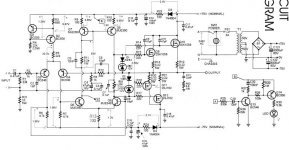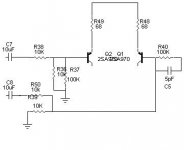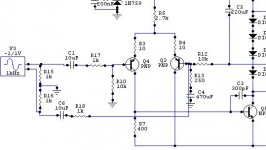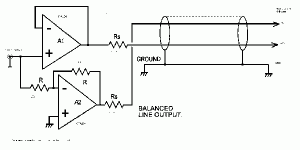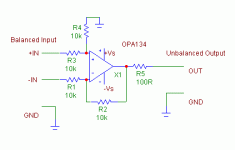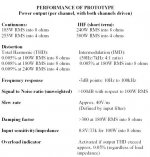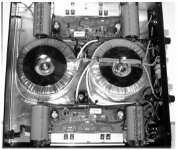The resistor values are high enough so to not put excessive load in the preceding stage, unless you are using a pre "really" capable of driving lower loads. With the values shown the input impedance is a bout 10K unbal and 25K when balanced.
Putting a cap in series with R39 greatly increases the quantity of DC at the output.
Regards,
Mambo
Putting a cap in series with R39 greatly increases the quantity of DC at the output.
Regards,
Mambo
Passive Soloution
Minh,
A car audio DC isolation transformer box works fine.
You may need to load down the secondary to avoid peaking response, and you can add a reversing switch to provide polarity reversal.
Car audio shops, St Lucia Electronics or WesComponents are a source.
$15-$30 for stereo.
I use this on my workbench and it works great - nobody has complained about the sound I'm getting.
Eric.
Minh,
A car audio DC isolation transformer box works fine.
You may need to load down the secondary to avoid peaking response, and you can add a reversing switch to provide polarity reversal.
Car audio shops, St Lucia Electronics or WesComponents are a source.
$15-$30 for stereo.
I use this on my workbench and it works great - nobody has complained about the sound I'm getting.
Eric.
a matter of balance
Hugo's schematic may work ok but bear in mind that the connection between -'ve input and the feedback node will tend to make the amp gain dependent on input impedance. I would think this would be undesireable.
PMA's approach looks better to me (although it adds more circuitry). Although using 2 op-amps is unecessary if you use a single op-amp in adder configuration: plus signal into the +'ve input with an R to gnd. Neg signal to -'ve input through a series R and and R from 've input to output.
Of course you could also configure the amp itself as an adder but the need for stabilizing components and the low resistance from -'ve input to gnd may not be desireable for the inputs (depends whats driving the inputs).
Another way is simply to use only one half of the unbalanced input signal. Ignore the other half. This will work fine although the noise cancelling benefits of the balance line will be lost, but sometimes this is an acceptable compromise.
Good luck,
BAM
Hugo's schematic may work ok but bear in mind that the connection between -'ve input and the feedback node will tend to make the amp gain dependent on input impedance. I would think this would be undesireable.
PMA's approach looks better to me (although it adds more circuitry). Although using 2 op-amps is unecessary if you use a single op-amp in adder configuration: plus signal into the +'ve input with an R to gnd. Neg signal to -'ve input through a series R and and R from 've input to output.
Of course you could also configure the amp itself as an adder but the need for stabilizing components and the low resistance from -'ve input to gnd may not be desireable for the inputs (depends whats driving the inputs).
Another way is simply to use only one half of the unbalanced input signal. Ignore the other half. This will work fine although the noise cancelling benefits of the balance line will be lost, but sometimes this is an acceptable compromise.
Good luck,
BAM
Minh
Please , give us more information about this amplifier.
It is a "pro" or "hi-fi" amplifier ?
How it work on 4 ohms ?
How it is sound quality ?
Regards ,
Please , give us more information about this amplifier.
It is a "pro" or "hi-fi" amplifier ?
How it work on 4 ohms ?
How it is sound quality ?
Regards ,
BAM,
the reason of using 2 opamps (in general) is to maintain the same output impedance of the + and - output. The circuit should not be influenced by following circuitry.
Pavel
the reason of using 2 opamps (in general) is to maintain the same output impedance of the + and - output. The circuit should not be influenced by following circuitry.
Pavel
PMA,
I don't understand what you mean. The way I see it when a single op-amp is used the output impedance is identical for either input by definition - since there is only one output. Also, it will be much lower because output resistors are not needed to add the signals together.
BAM
I don't understand what you mean. The way I see it when a single op-amp is used the output impedance is identical for either input by definition - since there is only one output. Also, it will be much lower because output resistors are not needed to add the signals together.
BAM
BAM,
maybe there is a misunderstanding. I was speaking about conversion from single-ended source to balanced one and in that case I have 2 outputs of the converter: (+) and (-).
Pavel
maybe there is a misunderstanding. I was speaking about conversion from single-ended source to balanced one and in that case I have 2 outputs of the converter: (+) and (-).
Pavel
Thanks everyone for your support. (I didn't think I'll get a reply).
Anyway, this amp was originally designed by Electronics Australia - (Magazine) as a constructors kit. They called it "Playmaster Pro Series - Three". Those who live is Australia can still buy this amp at Jaycar Electronics for AU$599.
You can download a copy the construction manual including design details.
http://www.jaycar.com.au/PDFS/KA1760.pdf
I'm quite happy with the amp's quality, power and stability. I've adjust the offset to 0mV, the noise did drop by a large margin. But if you put your ear right infront the speaker you can still hear hums (~60Hz). I'm guessing that it's the toroidal that inducing the noise into the low level input. Hence the idea for balance input.
I've try the circuit that that Mambo suggest on PSPICE (EWB), it works fine but too scare that actual component won't behave the same. While I'm at it, would I get better quality if i switch the 1st Differential pair (BJT- BC640) with MOSFET.
By the way the amp is a dual mono configuration and fairly tight internal spacing. I've added main filter (.47uF) and Spkr protector unit.
* I use a NAD 114 pre-amp, as it has an Alp-pot that is quite rare in Australia. I'm also thinkinng of converting this pre-amp to have balance output. (Does anyone know where I can get a schematic for this without spending alot of money).
* I built my Bookself out of 33mm MDF, using Vifa drivers (D25G, P17WJ)
* Spkr wires are Cat 5 Braided.
Does anyone have any tips on reducing the hum on the speaker?
I thank everyone again for your contribution, as your ideas are most helpful.
Anyway, this amp was originally designed by Electronics Australia - (Magazine) as a constructors kit. They called it "Playmaster Pro Series - Three". Those who live is Australia can still buy this amp at Jaycar Electronics for AU$599.
You can download a copy the construction manual including design details.
http://www.jaycar.com.au/PDFS/KA1760.pdf
I'm quite happy with the amp's quality, power and stability. I've adjust the offset to 0mV, the noise did drop by a large margin. But if you put your ear right infront the speaker you can still hear hums (~60Hz). I'm guessing that it's the toroidal that inducing the noise into the low level input. Hence the idea for balance input.
I've try the circuit that that Mambo suggest on PSPICE (EWB), it works fine but too scare that actual component won't behave the same. While I'm at it, would I get better quality if i switch the 1st Differential pair (BJT- BC640) with MOSFET.
By the way the amp is a dual mono configuration and fairly tight internal spacing. I've added main filter (.47uF) and Spkr protector unit.
* I use a NAD 114 pre-amp, as it has an Alp-pot that is quite rare in Australia. I'm also thinkinng of converting this pre-amp to have balance output. (Does anyone know where I can get a schematic for this without spending alot of money).
* I built my Bookself out of 33mm MDF, using Vifa drivers (D25G, P17WJ)
* Spkr wires are Cat 5 Braided.
Does anyone have any tips on reducing the hum on the speaker?
I thank everyone again for your contribution, as your ideas are most helpful.
Attachments
Re: a matter of balance
yes indeed, I noticed that with further simulations, is there a way to make it less (or non-) dependent? I'm going to check that out....
HB.
traderbam said:Hugo's schematic may work ok but bear in mind that the connection between -'ve input and the feedback node will tend to make the amp gain dependent on input impedance. I would think this would be undesireable.
yes indeed, I noticed that with further simulations, is there a way to make it less (or non-) dependent? I'm going to check that out....
HB.
Minh said:I'm quite happy with the amp's quality, power and stability. I've adjust the offset to 0mV, the noise did drop by a large margin. But if you put your ear right infront the speaker you can still hear hums (~60Hz). I'm guessing that it's the toroidal that inducing the noise into the low level input. Hence the idea for balance input.
If your hum is due to magnetic field coupling from the power transformer into the amplifier's circuit, then adding a balanced input won't help you one bit. You'll need to either magnetically shield the circuit and/or the transformer, or relocate/reorient the power transformer.
A balanced input only helps to reduce common-mode noise on the line feeding the amplifier's input. And unless you're using some highly inductive cable, that's not likely the problem.
Simply unplug the interconnects from the amp. If you still hear the hum, there's not much point bothering with a balanced input.
Good luck!
se
Hum
>I'm quite happy with the amp's quality, power and stability. I've adjust the offset to 0mV, the noise did drop by a large margin.
This is strange: offset up to +/-100mv or so shouldn't affect noise. Maybe sound quality, though I doubt it. Perhaps you should investigate the source for that noise somewhere else.
>But if you put your ear right infront the speaker you can still hear hums (~60Hz). I'm guessing that it's the toroidal that inducing the noise into the low level input. Hence the idea for balance input.
If you really want to investigate the hum cause, why don't you try putting the transformer away from the amp and see if it improves. Then you could see if there's really an induction. Turning the transformer (using thick rubber gloves) with the amp on may also improve hum.
There's a third option that might improve things, which is putting one bridge on each secondary and then joining the central - and + at the star ground.
Unsing a balanced input will not necessarily improve what you describe.
Carlos
>I'm quite happy with the amp's quality, power and stability. I've adjust the offset to 0mV, the noise did drop by a large margin.
This is strange: offset up to +/-100mv or so shouldn't affect noise. Maybe sound quality, though I doubt it. Perhaps you should investigate the source for that noise somewhere else.
>But if you put your ear right infront the speaker you can still hear hums (~60Hz). I'm guessing that it's the toroidal that inducing the noise into the low level input. Hence the idea for balance input.
If you really want to investigate the hum cause, why don't you try putting the transformer away from the amp and see if it improves. Then you could see if there's really an induction. Turning the transformer (using thick rubber gloves) with the amp on may also improve hum.
There's a third option that might improve things, which is putting one bridge on each secondary and then joining the central - and + at the star ground.
Unsing a balanced input will not necessarily improve what you describe.
Carlos
I'm sorry, I didn't made I self clean. But your both right, I'll try moving the Trans away from the circuit.
Because the casing is particularly attractive and the fact that I'm low in budget, made me reluctant to change to a larger casing where the trans can be more isolated. Or even do Mono block instead of dual mono.
This is probability a stupid Qs, but a is there a way to shield transformers?. I've got an old Yamaha A-760 using non-toroidal trans, anyway, they had a square metalic capsule around it. Would this help shielding or just to look pretty?.
What I mean before was by adjusting the DC offset to 0mV, the diaphram of the speaker stays at equilibrium when amp is on and relay connects.
And having no DC also means that when connected to the pre-amp (which is also 0mV offset) no current will draw from either device ('cause the're both at the same potential), hence minimise any possible noise.
If anyone knows a way to shield transformers without rearranging the case then please let me know as would be a great help to my problem.
As of this stage, think only solution is to relocate the trans.
Because the casing is particularly attractive and the fact that I'm low in budget, made me reluctant to change to a larger casing where the trans can be more isolated. Or even do Mono block instead of dual mono.
This is probability a stupid Qs, but a is there a way to shield transformers?. I've got an old Yamaha A-760 using non-toroidal trans, anyway, they had a square metalic capsule around it. Would this help shielding or just to look pretty?.
What I mean before was by adjusting the DC offset to 0mV, the diaphram of the speaker stays at equilibrium when amp is on and relay connects.
And having no DC also means that when connected to the pre-amp (which is also 0mV offset) no current will draw from either device ('cause the're both at the same potential), hence minimise any possible noise.
If anyone knows a way to shield transformers without rearranging the case then please let me know as would be a great help to my problem.
As of this stage, think only solution is to relocate the trans.
Attachments
penny drops
PMA: yes I now understand the confusion I was having earlier. You are right. The balanced to single-ended op amp circuit you show is correct by my reckoning.
Minh: I would say a couple of things. If you don't hear hum unless you stuff you face into your speaker cone then perhaps it isn't worth rebuilding your amp (nice photo!). Also, in my experience any hum (with no source connected) is rarely from transformer radiated noise, but rather from wrongly shared grounds or from circuit instability. This will be certainly true if the noise level changes when you adjust the dc offset. Check the grounding - that's a common culprit and is relatively easy to deal with.
BAM
PMA: yes I now understand the confusion I was having earlier. You are right. The balanced to single-ended op amp circuit you show is correct by my reckoning.
Minh: I would say a couple of things. If you don't hear hum unless you stuff you face into your speaker cone then perhaps it isn't worth rebuilding your amp (nice photo!). Also, in my experience any hum (with no source connected) is rarely from transformer radiated noise, but rather from wrongly shared grounds or from circuit instability. This will be certainly true if the noise level changes when you adjust the dc offset. Check the grounding - that's a common culprit and is relatively easy to deal with.
BAM
Completely agreed with BAM on what might be the ways to improve on your problems. If it's not too serious forget it.
Do you know how groundings are organized inside your amp? A rearrangement there might improve things a lot.
I don't see a star ground anywhere on the photo. Group together and separate the input grounds, feedback grounds, output grounds and supply grounds and send them as groups to the star ground. Be careful what you connect to the input ground.
There are ways to shield a transformer, using mu-metal. Nowadays you can get small sheets and even tapes, though I'm not experienced with any of them to tell what might help you. Maybe sombody on this Forum is.
Some transformer manufacturers sometimes sell shielding parts too. Try to see who makes yours and contact them.
Carlos
Do you know how groundings are organized inside your amp? A rearrangement there might improve things a lot.
I don't see a star ground anywhere on the photo. Group together and separate the input grounds, feedback grounds, output grounds and supply grounds and send them as groups to the star ground. Be careful what you connect to the input ground.
There are ways to shield a transformer, using mu-metal. Nowadays you can get small sheets and even tapes, though I'm not experienced with any of them to tell what might help you. Maybe sombody on this Forum is.
Some transformer manufacturers sometimes sell shielding parts too. Try to see who makes yours and contact them.
Carlos
- Status
- Not open for further replies.
- Home
- Amplifiers
- Solid State
- How to convert Unbalance -> Balance Input ?
